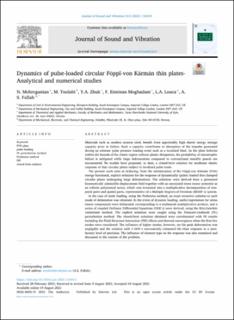Dynamics of Pulse-Loaded Circular Föppl-von Kármán Thin Plates-Analytical and Numerical Studies
Mehreganian, Navid; Toolabi, Milad; Zhuk, Yaroslav; Etminan Moghadam, Farnoosh; Louca, Luke A.; Soleiman Fallah, Arash
Peer reviewed, Journal article
Published version
Permanent lenke
https://hdl.handle.net/11250/2980102Utgivelsesdato
2021-08-26Metadata
Vis full innførselSamlinger
Originalversjon
Journal of Sound and Vibration. 2021, 513 . https://doi.org/10.1016/j.jsv.2021.116413Sammendrag
Materials such as modern armour steel, benefit from appreciably high elastic energy storage capacity prior to failure. Such a capacity contributes to absorption of the impulse generated during an extreme pulse pressure loading event such as a localised blast. As the plate deforms within the bounds of the elastic region without plastic dissipation, the probability of catastrophic failure is mitigated while large deformations compared to conventional metallic panels are encountered. No studies have proposed, to date, a closed-form solution for nonlinear elastic response of thin circular plates subject to localised pulse loads. The present work aims at deducing, from the minimization of the F ̈oppl-von K ́arm ́an (FVK) energy functional, explicit solutions for the response of dynamically (pulse) loaded thin clamped circular plates undergoing large deformations. The solutions were derived from a presumed kinematically admissible displacement field together with an associated stress tensor potential as an infinite polynomial series, which was truncated into a multiplicative decomposition of tem-poral parts and spatial parts, representative of a Multiple Degrees-of-Freedom (MDOF’s) system. In the case of static loading, using the Frobenius method, an exact recursive solution to each mode of defamation was obtained. In the event of dynamic loading, useful expressions for stress tensor components were delineated, corresponding to a multimode multiplicative product, and a series of coupled Ordinary Differential Equations (ODE’s) were derived, using the Ritz-Galerkin variational method. The explicit solutions were sought using the Poincar ́e-Lindstedt (PL) perturbation method. The closed-form solutions obtained were corroborated with FE results including the Fluid-Structure Interaction (FSI) effects and showed convergence when the first few modes were considered. The influence of higher modes, however, on the peak deformation was negligible and the solution with 3 DOF’s conveniently estimated the blast response to a satis-factory level of precision. The influence of element type on the response was also examined and discussed in the context of the problem.

